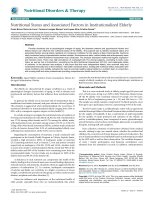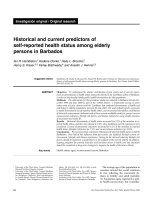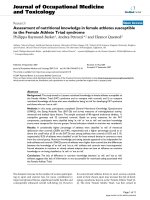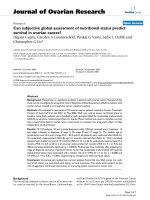Assessment of nutritional status among primary schoolchildren in krong bong district, daklak province
Bạn đang xem bản rút gọn của tài liệu. Xem và tải ngay bản đầy đủ của tài liệu tại đây (981.49 KB, 104 trang )
CERTIFICATION
I certify this thesis has entirely done by myself. Within my knowledge
quotations and data used in the thesis are cited and surveyed by highest precision
sources.
Phan Thi Ngoc Ngan
TABLE OF CONTENTS
CERTIFICATION
TABLE OF CONTENTS
LIST OF ABBREVIATIONS
LIST OF TABLES
LIST OF FIGURES
ABSTRACT
CHAPTER 1: PROBLEM STATEMENT ........................................................................... 1
1. Research backround ......................................................................................................... 1
1.1 Nutritional status in children in the world .....................................................................1
1.2 Nutritional status in children in Vietnam .......................................................................4
1.3 Current nutritional status in children in Krong Bong ....................................................6
1.4 Objective of the thesis ....................................................................................................8
1.4.1 General objective ........................................................................................................8
1.4.2 Specific objectives ......................................................................................................9
1.4.3 Research questions ......................................................................................................9
1.5 Scope of the research ....................................................................................................9
1.7 Structure of the thesis ...................................................................................................10
CHAPTER 2: LITERATURE REVIEW ........................................................................... 11
2.1 Measurement of nutritional status ................................................................................ 11
2.2 Anthropometric Indicators ........................................................................................... 12
2.3 Situation of nutritional status in the world ................................................................... 14
2.3.1 Characteristics of individuals children ......................................................................15
2.3.2 Characteristics of mothers/caregivers .......................................................................16
2.3.3 Characteristics of households....................................................................................18
2.4 Situation of nutritional status in Vietnam .................................................................... 20
2.5 Analytical Framework .................................................................................................. 22
CHAPTER 3: STUDY SUBJECTIVES AND METHODOLOGY ................................ 24
3.1General information about Krong Bong District .......................................................... 24
3.2 Study design ................................................................................................................. 25
3.2.1 Study setting ..............................................................................................................25
3.2.2 Sample size................................................................................................................26
3.2.3. Study subjects...........................................................................................................27
3.3 Statistical analysis ...................................................................................................... 27
3.4 Empirical Model........................................................................................................... 29
3.5 Variables in the model ................................................................................................. 31
3.5.1 Dependence variable .................................................................................................33
3.5.2 Independence variable ...............................................................................................34
CHAPTER 4: DESCRIPTION OF NUTRITIONAL STATUS IN KRONG BONG,
DAK LAK .......................................................................................................................... 35
4.1 Characteristics of child nutritional status ..................................................................... 35
4.1.1 Prevalence of current nutritional status in children ..................................................36
4.1.2 Prevalence of nutritional status in children by chronic, delivery status and place
of birth ................................................................................................................................39
4.1.3 Prevalence of nutrition status in children by mother/caregiver education and
occupation ..........................................................................................................................40
4.1.4 Prevalence of factors related family..........................................................................41
4.2 Risk factors of nutritional status .................................................................................. 46
4.2.1. Univariate analysis ...................................................................................................46
4.2.2. Multivariate analysis ................................................................................................50
CHAPTER 5: CONCLUSION AND RECOMMENDATION ......................................... 54
5.1. Conclusion................................................................................................................... 54
5.1.1 Conclusion of situation of nutritional status .............................................................54
5.1.2 Conclusion of risk factors of nutritional status .........................................................55
5.2 Recommendations ........................................................................................................ 55
5.3 Researchers and developments .................................................................................... 56
REFERENCES ................................................................................................................... 1
APPENDICIES ................................................................................................................... 7
LIST OF ABBREVIATIONS
BMI
Body Mass Index
CDC
Centers for Disease Control and Prevention
IOTF
International Obesity Task Force
FAO
Food and Agriculture Organization
HAZ
Height for age z-score (stunting)
MDGs
Millennium Development Goals
OR
Odd Ratio
PHC
Primary Health Care
SD
Standard deviation
UNICEF
United Nations International Children’s Emergency Fund
WAZ
Weight for age z-score (underweight)
WB
World Bank
WHO
World Health Organization
WHZ
Weight for height z-score (wasting)
LIST OF TABLES
Table 1.2.3. The statistics on the nutritional status of children in Dak Lak province over
the years (2005-2014) ..........................................................................................................7
Table 2.2.1. Overview of indicators and cut offs that are considered appropriate to
assess malnutrition in school-aged children .......................................................................13
Table 2.2.2. Mean (± SD) prevalence (%) of malnutrition in school-aged children, by
WHO region, weighted for quality score ...........................................................................14
Table 3.4. Summarizes the variables in this study. ............................................................31
Table 4.1. Summary of children's BMI-for-Age ................................................................35
Table 4.1.1. Prevalence of nutrition status in children by commune, sex, age, number of
children and ethnicity .........................................................................................................36
Table 4.1.1. Prevalence of nutrition status in children by commune, sex, age, number of
children and ethnicity (con’t) .............................................................................................37
Table 4.1.2. Prevalence of nutritional status in children by chronic, delivery status and
place of birth ......................................................................................................................39
Table 4.1.3. Prevalence of nutrition status in children by mother/caregiver education
and occupation ...................................................................................................................40
Table 4.1.4a. Prevalence of nutritional status in children by boil drinking water,
mosquito-net, latrine and garbage ......................................................................................41
Table 4.1.4b. Prevalence of nutritional status in children by family factors .....................43
Table 4.2.1a. Group variables of children ..........................................................................46
Table 4.2.1b. Group variables of mother/caregiver ...........................................................47
Table 4.2.1c. Group variables of households .....................................................................48
Table 4.2.2a. Group variables of children ..........................................................................50
Table 4.2.2b. Group variables of mother/caregiver ...........................................................50
Table 4.2.2c. Group variables of households .....................................................................51
LIST OF FIGURES
Figure 1. Map of Dak Lak province showing Krong Bong district ...................................24
Figure 2: Krong Bong District Map ...................................................................................25
Figure 1.2.2. The statistics on the nutritional status of children over the years (19992014) (National Institute of Nutrition). ................................................................................6
Figure 2.5: Conceptual framework on the causes of malnutrition (UNICEF, 1997) .........23
Figure 3.1.3 Analytical framework: illustration of hypotheses related to the relationship
between nutritional status in children and related factors. .................................................27
Figure 4.1. Prevalence of nutritional status in school-age children ...................................35
ABSTRACT
Background: The nutritional status of children reflects the socioecomy of family and
community as well as the efficiency of the health system. Malnutrition and overweight
in school-age children are an important public health problem of the Ministry of Health
and the Government of Vietnam. Within the country, Dak Lak province has the highest
levels of malnutrition.
Objectives: The aim of this study was to assess the nutritional status of primary school
children and to find out factors associated with childhood malnutrition and
overweight/obesity.
Methods: A cross-sectional household survey was carried out on five primary schools
of five communes in Krong Bong district, Dak Lak provinces during 30th March to 28th
April, 2015 by interviewing 321 children and their mothers/caregivers by using
questionnaire. Anthropometric measurement such as body weight (kg), and height of
children (m2) was collected by using standard techniques. Body Mass index was used
to define nutritional status according the WHO guideline.
Result: Prevalence of malnutrition in Krong Bong district was 26.5%. School boys
were more malnourished than school girls. Prevalence of overweight was 8.4% and
school girls were more overweight than school boys. The occurrence of malnuttrition
was dependence associated with commune and boil drinking water. Furthermore, the
occurrence of overweight were dependence associated with gender of children,
mother’s occupation, facility of birth, land-owning households.
1
ASSESSMENT OF NUTRITIONAL STATUS AMONG
PRIMARY SCHOOL CHILDREN IN KRONG BONG
DISTRICT, DAK LAK PROVINCE
CHAPTER 1: PROBLEM STATEMENT
1. Research backround
1.1 Nutritional status in children in the world
The nutritional status of children reflects the socioecomy of family and
community as well as the efficiency of the health system. Malnutrition in school-age
children are an important public health problem in the world.
The worldwide number of children stunting was 171 million (167 million in
developing countries) in 2010. The risk of childhood stunting reduced to 13 points
from year 1990 to 2010, 39.7 (95%CI 38.1, 41.4) % down to 26.7 (95% CI 24.8,
28.7) % respectively. The expected trend was 21.8 (95% CI 19.8, 23.8) %, or 142
million, in 2020. The prevalence of stunting in Asia decreased faster than Africa during
period from 1990 to 2010. Althougt Africa stunting has stagnated lower since 1990 at
about 40% but little improvement is anticipated, while Asia showed at 49% in 1990
then reduced to 28% in 2010, decreasing from 190 million to 100 million. This trend
will continue and that in 2020 Asia and Africa will have similar numbers of stunted
children (68 million and 64 million, respectively). Rates were much lower (14% or 7
million in 2010) in Latin America (de Onis et al., 2012).
In 2010, there were 43 million children in overweight and obesity (35 million in
developing countries) and 92 million were at risk of overweight. The global prevalence
2
of childhood overweight and obesity increased from year 1990 to 2010, 4.2% (95% CI:
3.2%, 5.2%) up to 6.7% (95% CI: 5.6%, 7.7%) respectively. The expected trend was
reach 9.1% (95% CI: 7.3%, 10.9%), or ~60 million, in 2020. The estimated prevalence
of childhood overweight and obesity in Africa in 2010 and in 2020 were 8.5% (95%
CI: 7.4%, 9.5%) and 12.7% (95% CI: 10.6%, 14.8%) respectively (de Onis et al.,
2010).
In September 2014, United Nations International Children’s Emergency
Fund (UNICEF), World Health Organization (WHO) and the World Bank (WB) made
public an updated final joint dataset on child malnutrition indicators (stunting, wasting,
severe wasting, overweight and underweight) and new global & regional estimated for
2013. There were 161 million children under-five year olds were stunted, 51 million
were wasted and 17 million were severely wasted, and 42 million were overweight and
99 million were underweight. The global trend of prevalence of stunting, wasting,
severe wasting, and underweight decreased, while the prevalence of overweight
increased in many regions. Between 2000 and 2013, the prevalence of overweight
increased from 11% to 19% in Southern Africa, and from 3% to 7% in Southeastern
Asia, and prevalence of stunting declined from 33% to 25%, or 199 million to 161
million children; prevalence of underweight was from 25% to 15%; prevalence of
wasting in 2013 was estimated at almost 8% and nearly a third of that was for severe
wasting, totaling 3%; and approximately two thirds of all wasted children lived in Asia
and almost one third in Africa, with similar proportions for severely wasted children. In
2013, about half of all stunted children lived in Asia and over one third in Africa. This
country has experience the smallest relative decreasing, with prevalence of
underweight was down at 17% in 2013 and 23% in 1990, in Asia it declined from 32%
to 18% perspectively and in Latin America and the Caribbean from 8% to 3% same
period. This means Asia and Latin America and the Caribbean were likely to meet the
3
Millennium Development Goals while Africa was likely to fall short, reaching about
only half of the targeted reduction. In terms of regional breakdowns in numbers of
overweight children in 2013, there were an estimated 18 million under-fives in Asia, 11
million in Africa and four million in Latin America and the Caribbean, countries with
large populations like Argentina, Bolivia, Brazil, Chile and Peru observed levels of 7%
and higher (UNICEF-WHO-The World Bank 2013).
Source: Joint child malnutrition estimates - Levels and trends (UNICEF-WHO-The
World Bank 2013).
School age is the active growing phase of childhood (SCN news, 1998). The
present scenario of health and nutritional status of the school-age children in India was
very unsatisfactory. The national family health survey (NFHS) data showed that the
4
prevalence of underweight was 53% of children in rural areas and this varies across
states. In the country, it was 53.4%, 45.8% and 47% for the years 1992, 1998, and 2006
respectively (Srivastava et al., 2012).
Recently, a worldwide statistics of WHO on overweight and obesity was related
to more deaths than underweight. Most of the world's population lived in countries
where overweight and obesity killed more people than underweight (this includes all
high-income and most middle-income countries). In 2013, there were 42 million
children under the age of five were overweight or obese. In 2014, more than 1.9 billion
adults, 18 years and older, were overweight. Of these over 600 million were obese. In
2014, the prevalence of obesity and overweight was about 13%, 39%, of those world’s
adult population (11% of men and 15% of women) and adults aged 18 years and over
(38% of men and 40% of women) respectively. Therefore the worldwide prevalence of
obesity was more than doubled between 1980 and 2014 (World Health Organization,
2015).
1.2 Nutritional status in children in Vietnam
In Vietnam, child health has been causing deep worry, as evidenced by within the
framework of the Millennium Development Goals, this issue is an important concern
for the Ministry of Health and the Government. The National Plan of Action for Child
Survival 2009-2015, developed with WHO support, has set the ambitious targets of
reducing the neonatal mortality rate to less than 10 per 1000 live births and under-5
mortality to less than 18 per 1000 live births by 2015 (World Health Organization).
Therefore, the WHO, UNICEF, Food and Agriculture Organization (FAO), though
nutrition indicators and health, recommended that the progress and existing problem
should be closely monitored in order to be able to intervene as soon as possible with
preventive and effective strategies. Vietnam is one of the Asian countries that has
5
achieved considerable success in the process of poverty reduction and lowering the
prevalence of malnourished children, especially children under-five years old (Ministry
of Health, 2012).
6
Figure 1.2.2. The statistics on the nutritional status of children over the years (19992014) (National Institute of Nutrition).
Thereby the problem of malnutrition in children under-five years old has
decreased noticeably from 1999 to 2014. Prevalence of underweight was from 36.7%
(1999) dropped to 14.5% (2014), and prevalence of stunting decreased from 38.7%
(1999) to 24.9% (2014). During 16 years, the prevalence of underweight was 22.2%
decrease, while stunting fell by 13.8%.
Factors related to nutritional status including income, land-owning households,
assets, animals raising (Srivastava et al., 2012) (Martorell et al., 1984) (Moestue, 2005)
(Cesare et al., 2015). Land is one of an indicator to measure the economic level of
family through deciding to plant trees adapt to each their ability and local weather. It
may consider a family income factor. In addition, characteristics of Vietnamese culture
is an agriculture, many factors related to income could not measure exactly as one plus
one are two, actually it has some invisible factors could not be measured are risen
family income. Therefore it is very difficult to identify precise income of working staff
or household income only base on questionnaire.
The economic conditions of households, shortage of rice, children have low birth
weight, giving birth at home, not monitoring weight and children suffered from
diarrhea in the last 2 weeks are the factors related to malnutrition status of children
under-five year of age (Le Thi Huong, 2014a).
1.3 Current nutritional status in children in Krong Bong
The proportion of malnutrition in children has differences between ecological
zones and regions. Accordingly, in the geographic orientation for projects to prevent
child malnutrition in the next level of the ecoregion has stunting rate, the highest of the
7
mountains and the north midlands, north central and Central Coast, Central Highlands
is also very important (Ministry of Health, 2012).
Thus, Dak Lak province has been selected as pilot site program on nutrition
intervention project "Improving the health of mothers and children of ethnic minorities
through behavioural health benefit (Atlantic Philanthropies) in the first two years (from
2011 to 2013). One of the reasons that Dak Lak was selected by the project due to its
highest nationwide prevalence of malnutrition of children under age five (CCRD
ORG).
Table 1.2.3. The statistics on the nutritional status of children in Dak Lak province
over the years (2005-2014)
YEAR
Underweight
(SDD cân n ng/tu i)
Total
Moderate Severe
Stunting
(SDD chi u cao/tu i)
Very
severe
Total
WHZ (TCBP)
Wasting
Overweight Obesity
WHz >+2 WHz >+3
Moderate Severe
2005
34.3
28.3
5.9
0.1
41.6
24.1
17.5
6.9
2006
2007
2008
2009
32,8
30.4
29.1
28,4
27,4
25.7
5,3
4.6
0,1
0.1
23,4
23.5
17,0
17.7
25,5
2,8
0,1
40,4
41.2
39.5
38,8
21,6
17,2
6,8
7.2
7.2
7,0
2010
2011
2012
27
25.6
24.6
23.8
22.9
22.1
2.8
2.4
2.2
0.4
0.3
0.3
36.9
35.5
34.5
22.6
21.5
21
14.3
14
13.5
8.2
7.9
7.8
WHz <-2 WHz <- 3
2013
2014
23.4
21,5
20.4
18,0
2.7
3,3
0.3
0,2
33.8
32,8
19.00
18,5
14.8
14,3
6
7,2
1.1
1,8
2.1
1,5
0.7
0,3
8
Source: Author compiled from sources the prevalence of malnutrition in children
under-five years of age throughout the years (National Institute of Nutrition).
In Dak Lak province, from 2005 to 2014, prevalence of underweight decreased from
34.3% to 21.5% and prevalence of stunting reduced from 41.6% to 32.8%. Thus,
within 10 years, the situation of malnutrition in this province was still high compared
with the national average level.
According to the survey results, the prevalence of malnutrition in children in Krong
Bong district was highest in the Dak Lak province in 2012, the percentage of
underweight and stunting of under five-year children was 26.7% and 33.3%
respectively (
k L k đi n t , 7/2012). This is the reason why the assessment of
nutritional status among Primary school children in Krong Bong district, Dak
Lak province was chosen for the thesis.
The unbalance in health care in the province compared to the country affects the
overall development of the country. Acting representative of the WHO, Mr. Jeffery
Kobza, stated "Scientific evidence indicates that optimal nutrition is an important thing
to ensure that the child will learn more when growing up and work more efficiently and
attain the maximum height at maturity. When children are provided with adequate
nutrition that means the community has escaped poverty" (UNICEF, 2014).
1.4 Objective of the thesis
1.4.1 General objective
The general objective of this study is to assess the nutritional status and their
related factors among primary school children in Krong Bong district, Dak Lak
province.
9
1.4.2 Specific objectives
To assess the prevalence of malnutrition and overweight of the school-aged
children.
To determine the related factors to children including: sex, age and child
nutritional status.
To
determine
the
related
factors
to
mother/caregiver
including:
mother/caregiver’s education, mother/caregiver’s occupation.
To determine the related factors to household including: number of child,
commune, delivery status, living standard, land, boil drinking water,...
1.4.3 Research questions
Situation of nutrition (malnutrition, overweight) of school-aged children.
Is there any relation of the factors of household family level and nutritional
status in children?
Is there any impact of maternal factors on the nutritional status of the schoolaged children?
1.5 Scope of the research
The thesis focus on nutritional status among primary school children in Krong Bong
district, Dak Lak province. Underweight is defined as malnutrition. Therefore
nutritional status is defined as malnutrition, overweight and normal. Scope of the
research was carried out on five primary schools of five communes in Krong Bong
district, Dak Lak provinces by interviewing children and their mothers/caregivers by
using questionnaire. The five communes in Krong Bong district are Yang Reh, Hoa Le,
Eatrul, Hoa Son and Cu Pui.
10
1.6 General method
Findings of economic theories that relate to the study topics and descriptive
methodology of data collection on children of five primary schools, statistical analysis
and study subjectives. For this reason, the study applied multinomial logic model that
address problems similar or related to the issue to be investigated.
In addition, the thesis suggested some necessary recommendations on nutrition in
children for the district.
1.7 Structure of the thesis
The thesis includes five chapters. Chapter 1 is an introduction about geographical
features, administrative boundaries, the population density, ethnicities, nutritional
status in the world and within Vietnam, and research problem, research objective links
to Krong Bong, Dak Lak. Chapter 2 consists of a literature review which focuses on
finding out some evidence-based studies to explore the relationship of different factors
as children and maternal and household family level to address the nutritional status
among school-aged children. Study subjectives and methodology for data collection
and statistical analysis and empirical model is described in Chapter 3. Chapter 4
describes the results of this study in order to address the specific research questions.
Chapter 5 is conclusion and recommendations that concentrates the general discussion
is presented based on the results and some relevant studies, followed by the list of
references and other supporting documents in the appendix section.
11
CHAPTER 2: LITERATURE REVIEW
The chapter emphasizes on the findings of economic theories that relate to the
study topics to explore the relationship of different factors as characteristics of
children, mothers, and households to address the nutritional status among school-aged
children.
2.1 Measurement of nutritional status
Nutritional status can be assessed using clinical signs of malnutrition,
biochemical indicators and anthropometry (de Onis, 2000). There are summarized as
ABCD:
Anthropometry methods
Biochemical, laboratory methods
Clinical methods
Dietary evaluation methods
Indicators of anthropometric shortfall – especially low height and low weight-forage are uniquely suited for assessing absolute deprivation in developing countries.
Anthropometric indicators are relatively precise, readily available for most countries,
reflect the preferences and concerns of many poor people, consistent with reckoning
the phenomenon directly in the space of functioning, intuitive, easy to use for advocacy,
and consistent over time and across subgroups (Heltberg, 2009). Early identification of
undernourished patients in the healthcare setting, and their nutritional treatment, are
essential if the harmful effects of poor nourishment are to be avoided and care costs
kept down (Campos del Portillo et al., 2015).
12
2.2 Anthropometric Indicators
Anthropometry is the measurement of body height, weight and proportions.
Anthropometry thus has an important advantage over other nutritional indicators:
whereas biochemical and clinical indicators are useful only at the extremes of
malnutrition, body measurements are sensitive over the full spectrum. In addition,
anthropometric measurements are non-invasive, inexpensive and relatively easy to
obtain. The main disadvantage of anthropometry is its lack of specificity, as changes in
body measurements are also sensitive to several other factors, including intake of
essential nutrients, infection, altitude, stress and genetic background (de Onis, 2000).
There are three different classification systems by which a child or a group of
children compared to the reference population: Z scores (standard deviation scores),
percentiles and percent-of-median
(de Onis, 2000). According to the WHO, as
followings:
HAZ: Height for age z-score (stunting)
WAZ: Weight for age z-score (underweight)
WHZ: Weight for height z-score (wasting)
Using weight-for-height: WHO and UNICEF recommend the use of a cut-off for
weight-for height of above -3 SDs of the WHO standards to identify infants and
children (de Onis et al., 2007).
There were some methods for nutritional assessment including z-score (Stunting:
–2 SD from median or < 3rd percentile of WHO growth reference or Centers for
Disease Control and Prevention (CDC) growth charts), underweight: < –2 SD from
median), body mass index (BMI) however BMI is a simple index of weight-for-height
that is commonly used to measurement of nutritional status. It is defined as a person's
13
weight in kilograms divided by the square of his height in meters (kg/m2) (World
Health Organization, 2015).
BMI =
(kg/m2)
The three criteria above were chosen to represent these principles, and all studies
were scored on each criterion: the nutritional indicator and cut off used to identify
malnutrition. This qualification assured that a study could only achieve a high quality
score if an appropriate indicator was used to measure malnutrition. An overview of the
criteria and scoring system used to evaluate the studies on their quality is given in
tables 2.2.1 and 2.2.2 (Best et al., 2010).
Table 2.2.1. Overview of indicators and cut offs that are considered appropriate to
assess malnutrition in school-aged children
Condition
Appropriate
indicator
Appropriate cut off value
Stunting a
Height-for-age
< –2 SD from median or < 3rd percentile of WHO
growth reference or CDC growth charts
Underweight a
Weight-for-age
< –2 SD from median of WHO growth reference or
CDC growth charts
Thinness a
BMI-for-age
< –2 SD from median or < 5th percentile of WHO
growth reference or CDC growth charts
Overweight a
BMI-for-age
> + 1 SD from median or > 85th percentile of WHO
growth reference or CDC growth charts
> BMI value corrected to BMI = 25 in adults (IOTF)
Obesity a
BMI-for-age
> + 2 SD from median or > 95th percentile of WHO
growth reference or CDC growth charts
> BMI value corrected to BMI = 30 in adults (IOTF)
14
a. Anthropometric measures were evaluated based on WHO growth reference
(Committee, 1995), CDC growth charts (Kuczmarski et al., 2002), or IOTF, criteria
(Cole et al., 2000).
Table 2.2.2. Mean (± SD) prevalence (%) of malnutrition in school-aged children,
by WHO region, weighted for quality score
Condition a
South-East Asia
Stunting
29 ± 18
Underweight
39 ± 17
Thinness
34 ± 26
Overweight, including obesity
13 ± 9
a. Stunting is defined as low height-for-age, underweight as low weight-for-age,
thinness as low body mass index (BMI)-for age, overweight or obesity as high BMIfor-age.
2.3 Situation of nutritional status in the world
A study examines nutritional status in school-age slum to all children aged 5-15
years from three slums (Faltuganj, Kurramgotia and Kalibadi) between December 2010
and April 2011, was randomly selected from the urban area of the Bareilly district (UP),
India, elicit information on family characteristics like residence, religion, type of
family, education and occupation of parents; and information on individual
characteristics like age, sex (Srivastava et al., 2012).
15
A study of determinants of child malnutrition in the districts of Bara and Rautahat
of the Terai region of Nepal showed that age, district of residence, household income
were significant predictors of nutritional status (Martorell et al., 1984).
2.3.1 Characteristics of individuals children
Age of child
Children in the age group of 5-14 years are often considered as school-age. Since
1972, the United Nations Educational Scientific and Cultural Organization (UNESCO)
considers 6-11 years as primary school age and 12-17 years as secondary school age
for statistical purpose (Srivastava et al., 2012) .
The need to develop an appropriate single growth reference for the screening,
surveillance and monitoring of school-aged children and adolescents has been stirred
by two contemporary events: the increasing public health concern over childhood
obesity and the April 2006 release of the WHO Child Growth Standards for preschool
children based on a prescriptive approach. The reference previously recommended by
WHO for children above 5 years of age, i.e. the National Center for Health Statistics
(NCHS)/WHO international growth reference, has several drawbacks. In particular, the
body mass index-for-age reference, developed in 1991, only starts at 9 years of age,
group data annually and covers a limited percentile range. Many countries pointed to
the need to have body mass index curves that start at 5 years and permit unrestricted
calculation of percentile and z-score curves on a continuous age scale from 5 to 19
years (de Onis et al., 2007).
Age related differences were found significant for some of the test scores between
5–7 and 8–10 year old children in the adequately nourished group but not for most of









